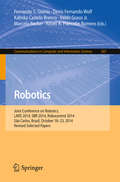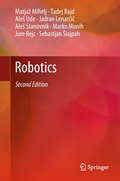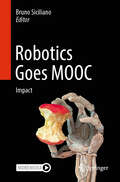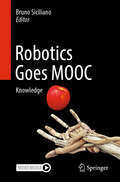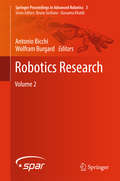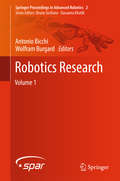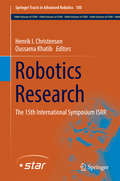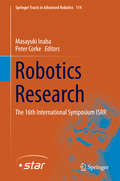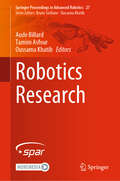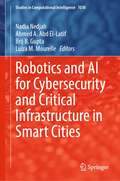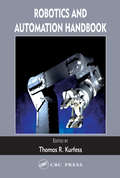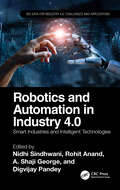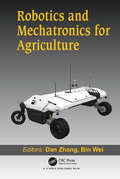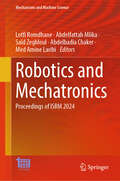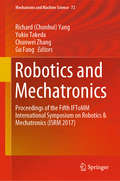- Table View
- List View
Robotics
by Fernando S. Osório Denis Fernando Wolf Kalinka Castelo Branco Valdir Grassi Marcelo Becker Roseli A. Francelin RomeroThis book constitutes the refereed proceedings of the Joint Conference on Robotics, LARS, SBR, Robocontrol 2014, held in São Carlos, Brazil, in October 2014. The 8 revised full papers presented were carefully reviewed and selected from 76 submissions. The selected papers present a complete and solid reference of the state-of-the-art of intelligent robotics and automation research, covering the following areas: autonomous mobile robots, tele-operated and telepresence robots, human-robot interaction, trajectory control for mobile robots, autonomous vehicles, service-oriented robotic systems, semantic mapping, environment mapping, visual odometry, applications of RGB-D sensors, humanoid and biped robots, Robocup soccer robots, robot control, path planning, multiple vehicles and teams of robots.
Robotics
by Fernando Santos Osório Rogério Sales GonçalvesThis book constitutes the refereed proceedings of the 12th Latin American Robotics Symposium and Third Brazilian Symposium on Robotics, LARS 2015 / SBR 2015, held in Uberlândia, Brazil, in October/November 2015. The 17 revised full papers presented were carefully reviewed and selected from 80 submissions. The selected papers present a complete and solid reference of the state-of-the-art of intelligent robotics and automation research, covering the following areas: autonomous mobile robots, tele-operated and telepresence robots, human-robot interaction, trajectory control for mobile robots, autonomous vehicles, service-oriented robotic systems, semantic mapping, environment mapping, visual odometry, applications of RGB-D sensors, humanoid and biped robots, Robocup soccer robots, robot control, path planning, multiple vehicles and teams of robots.
Robotics
by Kathy Ceceri Sam CarbaughOnce, robots were only found in science fiction books and movies. Today, robots are everywhere! They assemble massive cars and tiny computer chips. They help doctors do delicate surgery. They vacuum our houses and mow our lawns. Robot toys play with us, follow our commands, and respond to our moods. We even send robots to explore the depths of the ocean and the expanse of space. In Robotics, children ages 9 and up learn how robots affect both the future and the present. Hands-on activities make learning both fun and lasting.
Robotics (Intelligent Systems, Control and Automation: Science and Engineering #4)
by Marko Munih Matjaž Mihelj Tadej Bajd Jadran Lenarčič Aleš Ude Aleš Stanovnik Jure Rejc Sebastjan ŠlajpahThis book introduces readers to robotics, industrial robot mechanisms, and types of robots, e.g. parallel robots, mobile robots and humanoid robots. The book is based on over 20 years of teaching robotics and has been extensively class tested and praised for its simplicity.It addresses the following subjects: a general introduction to robotics; basic characteristics of industrial robot mechanisms; position and movement of an object, which are described by homogenous transformation matrices; a geometric model of robot mechanisms expanded with robot wrist orientation description in this new edition; a brief introduction to the kinematics and dynamics of robots; robot sensors and planning of robot trajectories; fundamentals of robot vision; basic control schemes resulting in either desired end-effector trajectory or force; robot workcells with feeding devices and robot grippers.This second edition has been expanded to include the following new topics: parallel robots; collaborative robots; teaching of robots; mobile robots; and humanoid robots. The book is optimally suited for courses in robotics or industrial robotics and requires a minimal grasp of physics and mathematics.The 1st edition of this book won the Outstanding Academic Title distinction from the library magazine CHOICE in 2011.
Robotics Goes MOOC: Design
by Bruno SicilianoA robot’s appearance and its way of interacting with humans is of fundamental importance. Until a few years ago there was a clear asymmetry between the typically excellent performance of industrial robots and their ugly and disharmonious bodies, with crude ways and potentially very dangerous movements for the human environment. A modern artifact can be as harmonious and beautiful as a complex biological machine or a work of plastic art and thus it should be clear how design plays a key role for robot technology to become a part of our everyday life and change it essentially in a responsible and beneficial manner. It is designers who shape the interface between humans and machines and, as such, they will contribute to make robots as customizable and intuitively useful to inexperienced users according to a plug-and-play mode. The new concept of robotronics as the mechatronics approach to designing advanced robots is the focus of the first chapter of the second book of the Robotics Goes MOOC project by Asfour et al. The main issues for robot manipulator design are covered in the subsequent material, namely redundant robots in Chapter 2 by Maciejewsky et al and parallel robots in Chapter 3 by Müller, where widely adopted kinematic solutions are presented. Then, the adoption to flexibilty, as opposed to the rigid mechanics paradigm, is discussed in Chapter 4 by Bertram et al with reference to elastic robots and in Chapter 5 by Laschi focused on soft robotics. Somewhat speculating on the previous two design solutions comes Chapter 6 by Cutkosky dealing with bioinspired robots. The last part of the book is devoted to robot locomotion, namely, Chapter 7 by Vendittelli on wheeled robots and Chapter 8 by Harada on (biped) humanoids.
Robotics Goes MOOC: Impact
by Bruno SicilianoIt is often read in the media that AI and Robotics are the primary cause of technology unemployment. AI and machine learning techniques are expected to take over lower-level tasks, while humans can spend more time with higher-level tasks. In perspective, it can be said that jobs requiring boring cognitive tasks or repeatable and dangerous physical tasks will be considerably shredded by automation thanks to the wide adoption of AI & Robotics technology to replace humans, while jobs requiring challenging cognitive tasks or unstructured physical tasks will be suitably re-engineered with the progressive introduction of AI & Robotics technology to assist humans.From the discussion above, it should be clear that in a world populated by humans and robots, issues arise that go beyond engineering and technology due to the impact resulting from the use of robots in various application scenarios. The anthropization of robots cannot ignore the resolution of those ethical, legal, sociological, economic (ELSE) problems that have so far slowed their spread in our society.The final book of the Robotics Goes MOOC project enlightens the impact of using robotic technology in the main fields of application, namely, industrial robots as in Chapter 1 by Bischoff et al, medical robotics as in Chapter 2 by Dario et al, aerial robots as in Chapter 3 by Ollero et al, orbital robotics as in Chapter 4 by Lampariello, underwater robots in Chapter 5 by Antonelli, and rescue robots as in Chapter 6 by Murphy. The last part is devoted to the open dilemma of using and accepting robots in human co-habited environments which is addressed in Chapter 7 on social robotics by Pandey and the very final chapter by Tamburrini on the important issues raised with roboethics.
Robotics Goes MOOC: Interaction
by Bruno SicilianoWith the massive and pervasive diffusion of robotics technology in our society, we are heading towards a new type of AI, which we call Physical AI at the intersection of Robotics with AI, that is the science of robots and intelligent machines performing a physical action to help humans in their jobs of daily lives. Physical assistance to disabled or elderly people; reduction of risks and fatigue at work; improvement of production processes of material goods and their sustainability; safety, efficiency and reduction of environmental impact in transportation of people and goods; progress of diagnostic and surgical techniques are all examples of scenarios where the new InterAction Technology (IAT) is indispensable.The interaction between robots and humans must be managed in a safe and reliable manner. The robot becomes an ideal assistant, like the tool used by a surgeon, a craftsman, a skilled worker. The new generation of robots will co-exist — the cobots— with humans not only in the workplace but, gradually, in homes and communities, providing support in services, entertainment, education, health, manufacturing and care.As widely discussed above, interaction plays a crucial role for the development of modern robotic systems. Grasping, manipulation and cooperative manipulators are covered in the first part of the third book of the Robotics Goes MOOC project, respectively in Chapter 1 by Prattichizzo et al, Chapter 2 by Kao et al, and Chapter 3 by Caccavale. Specific interaction issues along with the development of digital and physical interfaces are dealt with in Chapter 4 by Marchal et al and in Chapter 5 by Croft et al, respectively. Interaction between robot and human also means that a robot can be worn by a human as presented in Chapter 6 by Vitiello et al. A different type of interaction at a cognitive and planning level is the focus of Chapter 7 by Lima devoted to multi-robot systems and Chapter 8 by Song et al on networked, cloud and fog robotics, respectively.
Robotics Goes MOOC: Knowledge
by Bruno SicilianoThe robot “concept” was clearly established by those many creative historical realizations, such as those recalled above. Nonetheless, the emergence of the “physical” robot had to await the advent of its underlying technologies of mechanics, controls, computers, electronics and sensors ―in one word, mechatronics― during the course of the twentieth century. As always, new designs motivate new research and discoveries which, in turn, lead to enhanced solutions and thus to novel concepts. This virtuous circle over time produced that knowledge and understanding which gave birth to the field of Robotics, properly referred to as the science and technology of robots.To make robots and intelligent machines useful to humans it is necessary to have a broad and tight intersection between Robotics and AI. Sophisticated mathematical models are needed that enable the robot from a physical point of view, as well as intelligent algorithms capable of correlating all the information coming from the use of technologically advanced sensors with the data available from experience. It is expected that the synergy of model-based techniques with data-driven approaches will contribute to increasing the level of autonomy of robots and intelligent machines in the near future.The first book of the Robotics Goes MOOC project starts with the journey of robotics in the introductory chapter by Khatib, who has pioneered our field of robotics and has ferried it to the third millennium. Sensing is crucial for the development of intelligent and autonomous robots, as covered in Chapter 2 by Nüchter et al. Model-based control is dealt with in Chapter 3 by Kröeger et al along with motion planning, as well as in Chapter 4 by Villani and Chapter 5 by Chaumette to handle force and visual feedback, respectively, when interacting with the environment. Resorting to AI techniques is the focus of the last part of the book, namely, Chapter 6 by Peters et al on Learning, Chapter 7 byBeetz et al on knowledge representation and reasoning, and Chapter 8 by Burgard et al on graph-based SLAM.
Robotics Research
by Antonio Bicchi Wolfram BurgardISRR, the "International Symposium on Robotics Research", is one of robotics pioneering Symposia, which has established over the past two decades some of the field's most fundamental and lasting contributions. This book presents the results of the seventeenth edition of "Robotics Research" ISRR15, offering a collection of a broad range of topics in robotics. The content of the contributions provides a wide coverage of the current state of robotics research. : the advances and challenges in its theoretical foundation and technology basis, and the developments in its traditional and new emerging areas of applications. The diversity, novelty, and span of the work unfolding in these areas reveal the field's increased maturity and expanded scope and define the state of the art of robotics and its future direction.
Robotics Research
by Antonio Bicchi Wolfram BurgardISRR, the "International Symposium on Robotics Research", is one of robotics pioneering Symposia, which has established over the past two decades some of the field's most fundamental and lasting contributions. This book presents the results of the seventeenth edition of "Robotics Research" ISRR15, offering a collection of a broad range of topics in robotics. The content of the contributions provides a wide coverage of the current state of robotics research. : the advances and challenges in its theoretical foundation and technology basis, and the developments in its traditional and new emerging areas of applications. The diversity, novelty, and span of the work unfolding in these areas reveal the field's increased maturity and expanded scope and define the state of the art of robotics and its future direction.
Robotics Research
by Oussama Khatib Henrik I. ChristensenThis volume presents a collection of papers presented at the 15th International Symposium of Robotic Research (ISRR). ISRR is the biennial meeting of the International Foundation of Robotic Research (IFRR) and its 15th edition took place in Flagstaff, Arizona on December 9 to December 12, 2011. As for the previous symposia, ISRR 2011 followed up on the successful concept of a mixture of invited contributions and open submissions. Therefore approximately half of the 37 contributions were invited contributions from outstanding researchers selected by the IFRR officers and the program committee, and the other half were chosen among the open submissions after peer review. This selection process resulted in a truly excellent technical program which featured some of the very best of robotic research. The program was organized around oral presentation in a single-track format and included for the first time a small number of interactive presentations. The symposium contributions contained in this volume report on a variety of new robotics research results covering a broad spectrum including perception, manipulation, grasping, vehicles and design, navigation, control and integration, estimation and SLAM.
Robotics Research
by Masayuki Inaba Peter CorkeThis volume presents a collection of paperspresented at the 16th International Symposium of Robotic Research(ISRR). ISRR is the biennial meeting of the International Foundation of RoboticResearch (IFRR) and its 16th edition took place in Singapore overthe period 16th to 19th December 2013. The ISRR is the longest running seriesof robotics research meetings and dates back to the very earliest days ofrobotics as a research discipline. This 16th ISRR meeting was held in the 30thanniversary year of the very first meeting which took place in Bretton Woods(New Hampshire, USA) in August 1983. , and represents thirty years at theforefront of ideas in robotics research. As for the previous symposia, ISRR 2013followed up on the successful concept of a mixture of invited contributions andopen submissions. 16 of the contributions were invited contributions fromoutstanding researchers selected by the IFRR officers and the programcommittee, and the other contributions were chosen among the open submissionsafter peer review. This selection process resulted in a truly excellenttechnical program which featured some of the very best of robotic research. These papers were presented in a single-track interactive format which enablesreal conversations between speakers and the audience. The symposium contributions contained in thisvolume report on a variety of new robotics research results covering a broadspectrum organized into traditional ISRR categories: control; design;intelligence and learning; manipulation; perception; and planning.
Robotics Research (Springer Proceedings in Advanced Robotics #27)
by Oussama Khatib Aude Billard Tamim AsfourThe proceedings of the 2022 edition of the International Symposium of Robotics Research (ISRR) offer a series of peer-reviewed chapters that report on the most recent research results in robotics, in a variety of domains of robotics including robot design, control, robot vision, robot learning, planning, and integrated robot systems. The proceedings entail also invited contributions that offer provocative new ideas, open-ended themes, and new directions for robotics, written by some of the most renown international researchers in robotics. As one of the pioneering symposia in robotics, ISRR has established some of the most fundamental and lasting contributions in the field since 1983. ISRR promotes the development and dissemination of ground-breaking research and technological innovation in robotics useful to society by providing a lively, intimate, forward-looking forum for discussion and debate about the status and future trends of robotics, with emphasis on its potential role to benefit humans.
Robotics Research: The 18th International Symposium ISRR (Springer Proceedings in Advanced Robotics #10)
by Shawna Thomas Nancy M. Amato Greg Hager Miguel Torres-TorritiISRR, the "International Symposium on Robotics Research", is one of robotics pioneering Symposia, which has established over the past two decades some of the field's most fundamental and lasting contributions. This book presents the results of the eighteenth edition of "Robotics Research" ISRR15, offering a collection of a broad range of topics in robotics. This symposium took place in Puerto Varas, Chile from December 11th to December 14th, 2017. The content of the contributions provides a wide coverage of the current state of robotics research, the advances and challenges in its theoretical foundation and technology basis, and the developments in its traditional and new emerging areas of applications. The diversity, novelty, and span of the work unfolding in these areas reveal the field's increased maturity and expanded scope and define the state of the art of robotics and its future direction.
Robotics Research: The 19th International Symposium ISRR (Springer Proceedings in Advanced Robotics #20)
by Oussama Khatib Eiichi Yoshida Henrik Christensen Tamim Asfour Jaeheung ParkThis book contains the papers that were presented at the 17th International Symposium of Robotics Research (ISRR). The ISRR promotes the development and dissemination of groundbreaking research and technological innovation in robotics useful to society by providing a lively, intimate, forward-looking forum for discussion and debate about the current status and future trends of robotics with great emphasis on its potential role to benefit humankind.The symposium contributions contained in this book report on a variety of new robotics research results covering a broad spectrum organized into the categories: design, control; grasping and manipulation, planning, robot vision, and robot learning.
Robotics Theory and Industrial Applications, Second Edition
by Larry T. Ross Stephen W. Fardo James W. Masterson Robert L. TowersRobotics: Theory and Industrial Applications is an introduction to the principles of industrial robotics, related systems, and applications. This text is a comprehensive tool in learning the technical aspects of robotics and includes coverage of power supply systems, degrees of freedom, programming methods, sensors, end effectors, implementation planning, and system maintenance. Each chapter begins with an outline of topics, learning objectives, and a listing of technical terms. The key concepts are discussed using a systems approach to enhance student learning.<P> The second edition is updated with full-color illustrations and photos that reflect changes in both the field of robotics and technology in general. The content has been revised to keep pace with robotic technology and reorganized to maximize student comprehension. Various features throughout the text address special interest topics, including pioneers in the field of robotics, careers in robotics, and exciting applications of robotic technology.
Robotics and AI for Cybersecurity and Critical Infrastructure in Smart Cities (Studies in Computational Intelligence #1030)
by Nadia Nedjah Brij B. Gupta Ahmed A. Abd El-Latif Luiza M. MourelleThis book bridges principles and real-world applications, while also providing thorough theory and technology for the development of artificial intelligence and robots. A lack of cross-pollination between AI and robotics research has led to a lack of progress in both fields. Now that both technologies have made significant strides, there is increased interest in combining the two domains in order to create a new integrated AI and robotics trend. In order to achieve wiser urbanization and more sustainable development, AI in smart cities will play a significant part in equipping the cities with advanced features that will allow residents to safely move about, stroll, shop, and enjoy a more comfortable way of life. If you are a student, researcher, engineer, or professional working in this field, or if you are just curious in the newest advancements in robotics and artificial intelligence for cybersecurity, this book is for you!
Robotics and Automation Handbook
by Thomas R. KurfessAs the capability and utility of robots has increased dramatically with new technology, robotic systems can perform tasks that are physically dangerous for humans, repetitive in nature, or require increased accuracy, precision, and sterile conditions to radically minimize human error. The Robotics and Automation Handbook addresses the major aspects of designing, fabricating, and enabling robotic systems and their various applications. It presents kinetic and dynamic methods for analyzing robotic systems, considering factors such as force and torque. From these analyses, the book develops several controls approaches, including servo actuation, hybrid control, and trajectory planning. Design aspects include determining specifications for a robot, determining its configuration, and utilizing sensors and actuators. The featured applications focus on how the specific difficulties are overcome in the development of the robotic system. With the ability to increase human safety and precision in applications ranging from handling hazardous materials and exploring extreme environments to manufacturing and medicine, the uses for robots are growing steadily. The Robotics and Automation Handbook provides a solid foundation for engineers and scientists interested in designing, fabricating, or utilizing robotic systems.
Robotics and Automation in Industry 4.0: Smart Industries and Intelligent Technologies (Big Data for Industry 4.0)
by Nidhi Sindhwani, Rohit Anand, A. Shaji George, and Digvijay PandeyThe book presents the innovative aspects of smart industries and intelligent technologies involving Robotics and Automation. It discusses the challenges in the design of autonomous robots and provides an understanding of how different systems ommunicate with each other, allowing cooperation with other human systems and operators in real time. Robotics and Automation in Industry 4.0: Smart Industries and Intelligent Technologies offers research articles, flow charts, algorithms, and examples based on daily life in automation and robotics related to the building of Industry 4.0. It presents disruptive technology applications related to Smart Industries and talks about how robotics is an important Industry 4.0 technology that offers a wide range of capabilities and has improved automation systems by doing repetitive tasks with more accuracy and at a lower cost. The book discusses how frontline healthcare staff can evaluate, monitor, and treat patients from a safe distance by using robotic and telerobotic systems to minimize the risk of infectious disease transmission. Artificial intelligence (AI) and machine learning (ML) are looked at and the book offers a comprehensive overview of the key challenges surrounding the Internet of Things (IoT) and AI synergy, including current and future applications with significant societal value. An ideal read for scientists, research scholars, entrepreneurs, industrialists, academicians, and various other professionals who are interested in exploring innovations in the applicational areas of AI, IoT, and ML related to Robotics and Automation.
Robotics and Autonomous Systems and Engineering Applications of Computational Intelligence: 8th International Conference on Life System Modeling and Simulation, LSMS 2024, and 8th International Conference on Intelligent Computing for Sustainable Energy and Environment, ICSEE 2024, Suzhou, China, September 13–15, 2024, Proceedings, Part V (Communications in Computer and Information Science #2220)
by Fuyuan Hu Huiyu Zhou Juping Gu Zixiang Fei Erfu YangThe five-volume set constitutes the thoroughly refereed proceedings of the 8th International Conference on Life System Modeling and Simulation, LSMS 2024, and of the 8th International Conference on Intelligent Computing for Sustainable Energy and Environment, ICSEE 2024, which were held during September 13-15, in Suzhou, China. The 31 papers presented were carefully reviewed and selected from over 496 submissions. The LSMS and ICSEE international conference series aim to bring together international researchers and practitioners in the fields of advanced methods for life system modeling and simulation, as well as advanced intelligent computing theory, methodologies, and engineering applications in achieving net zero across all sectors to tackle the global climate change challenge.
Robotics and Mechatronics
by Jean-Pierre Gazeau Saïd Zeghloul Med Amine LaribiThis volume contains papers that have been selected after review for oral presentation at ISRM 2015, the Fourth IFToMM International Symposium on Robotics and Mechatronics held in Poitiers, France 23-24 June 2015. These papers provide a vision of the evolution of the disciplines of robotics and mechatronics, including but not limited to: mechanism design; modeling and simulation; kinematics and dynamics of multibody systems; control methods; navigation and motion planning; sensors and actuators; bio-robotics; micro/nano-robotics; complex robotic systems; walking machines, humanoids-parallel kinematic structures: analysis and synthesis; smart devices; new design; application and prototypes. The book can be used by researchers and engineers in the relevant areas of robotics and mechatronics.
Robotics and Mechatronics for Agriculture
by Dan Zhang Bin WeiThe aim of the book is to introduce the state-of-the-art technologies in the field of robotics, mechatronics and automation in agriculture in order to summarize and review the improvements in the methodologies in agricultural robotics. Advances made in the past decades are described, including robotics for agriculture, mechatronics for agriculture, kinematics, dynamics and control analysis of agricultural robotics, and a wide range of topics in the field of robotics, mechatronics and automation for agricultural applications.
Robotics and Mechatronics: Proceedings of ISRM 2024 (Mechanisms and Machine Science #158)
by Saïd Zeghloul Med Amine Laribi Lotfi Romdhane Abdelfattah Mlika Abdelbadia ChakerGathering the proceedings of the 8th IFToMM International Symposium on Robotics and Mechatronics (ISRM), held in Djerba, Tunisia, on April 17-19, 2024, this volume covers topics in the broad range of topics related to robotics and mechatronics such as mechanism design, modeling and simulation, kinematics and dynamics of multibody systems, navigation and motion planning, wireless sensors and wearable devices, biomechanics and bio-robotics, micro/nano-robotics, complex robotic systems, walking machines, humanoids, smart devices. The proceedings extend this platform to all researchers, scientists, industry experts, and students interested in these fields.
Robotics and Mechatronics: Proceedings of the 6th IFToMM International Symposium on Robotics and Mechatronics (ISRM 2019) (Mechanisms and Machine Science #78)
by Chin-Hsing Kuo Pei-Chun Lin Terence Essomba Guan-Chen ChenThis book gathers the latest advances, innovations and applications in the field of robotics and mechatronics, as presented by leading international researchers and engineers at the 6th IFToMM International Symposium on Robotics and Mechatronics (ISRM), held in Taipei, Taiwan, on October 28–30, 2019. It covers highly diverse topics, including mechanism synthesis, analysis, and design, kinematics and dynamics of multibody systems, modelling and simulation, sensors and actuators, novel robotic systems, industrial- and service-related robotics and mechatronics, medical robotics, and historical developments in robotics and mechatronics. The contributions, which were selected through a rigorous international peer-review process, share exciting ideas that spur novel research directions and foster new, multidisciplinary collaborations.
Robotics and Mechatronics: Proceedings of the Fifth IFToMM International Symposium on Robotics & Mechatronics (ISRM 2017) (Mechanisms and Machine Science #72)
by Richard Chunhui Yang Yukio Takeda Chunwei Zhang Gu FangThis book gathers the proceedings of the ISRM 2017, the fifth IFToMM International Symposium on Robotics and Mechatronics, which was jointly organised by the School of Computing, Engineering and Mathematics at Western Sydney University, Australia and by the IFToMM Technical Committee on Robotics and Mechatronics. The respective contributions showcase the latest advances, trends and future challenges in Computer Modelling and Simulation, Kinematics and Dynamics of Multi-Body Systems, Advanced Dynamics and Control Methods, Linkages and Mechanical Controls, Parallel Manipulators, Mechanism Design, Sensors and Actuators, Mobile Robotics: Navigation and Motion Planning, Bio-inspired Robotics, Micro/Nano-Robotics and Complex Robotic Systems.
